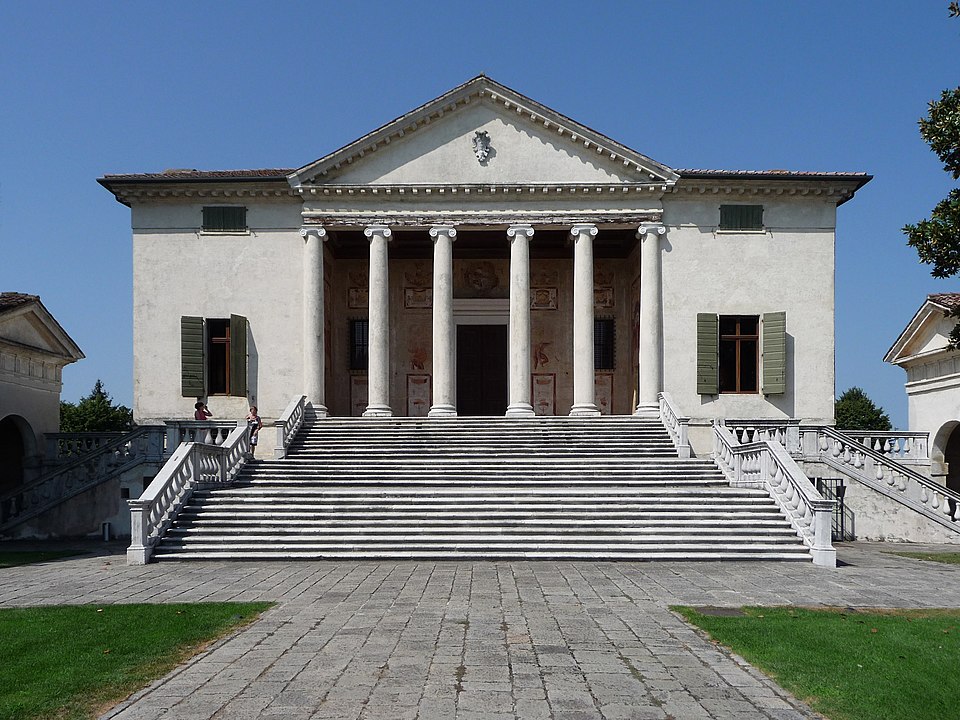Andrea Palladio, one of the most influential architects in history, died on 19 August 1580 in Vicenza. His work changed how buildings were designed across Europe and, later, America. Palladio was born in Padua in 1508 to a miller’s family. He trained as a stonemason before moving into architecture. His practical knowledge of stonework shaped his later precision in design.
Patronage played a crucial role in his career. In 1538, he met Giangiorgio Trissino, a humanist scholar who recognised his talent. Trissino introduced him to classical literature and Roman architecture, expanding his education beyond craft into theory. Palladio soon travelled to Rome, where he studied ancient ruins with careful detail. These experiences gave him a strong foundation to develop his style, blending classical harmony with practical function.
The birth of the Palladian style
Palladio’s genius lay in adapting classical Roman principles to the needs of Renaissance Italy. His buildings were elegant yet functional, with clean proportions and a sense of balance. He rejected unnecessary decoration in favour of clarity and order.
His style, later called Palladianism, emphasised symmetry, perspective, and proportion. Columns, pediments, and temple-like façades became recurring features. Yet Palladio did not simply copy Roman architecture. He adapted it to villas, palaces, and churches suited to his patrons’ lives.
The most striking innovation was his treatment of country villas. At a time when rural estates were often fortresses or farmhouses, Palladio created homes that blended utility with beauty. His designs integrated agriculture with leisure, reflecting the values of the Venetian elite.
Landmark works in Vicenza and Venice
Vicenza, Palladio’s adopted home, became a showcase of his talent. Many of his greatest works still stand in the city and its surrounding countryside.
The Basilica Palladiana, completed in 1614 after his death, was his first major commission. He redesigned the medieval town hall with a striking loggia of white stone, creating a harmonious public building. Its arcades with repeated arches became a model for civic architecture across Europe.
Another jewel is the Teatro Olimpico, built for the Accademia Olimpica in Vicenza. Completed after his death, the theatre reflects his vision. It is the oldest surviving indoor theatre in the world, with a permanent stage set of painted streets in perspective.
In Venice, Palladio designed two of the city’s most famous churches: San Giorgio Maggiore and Il Redentore. Both feature grand façades inspired by Roman temples, but scaled to the Venetian lagoon. Inside, the light-filled spaces show his mastery of proportion and serenity. Il Redentore, built after a plague, remains one of the most powerful religious monuments in the city.
The villas of Veneto

Palladio’s villas were more than homes. They symbolised a new way of living. Wealthy Venetian families wanted estates that combined agricultural productivity with comfort and prestige. Palladio delivered this vision.
His villas, scattered across the Veneto countryside, are defined by symmetry and classical references. The most famous, Villa La Rotonda, near Vicenza, became an icon. Designed with a central dome and four identical façades, it adapts the form of a Roman temple into a residence. Its perfect proportions inspired countless later buildings.
Other villas, such as Villa Barbaro in Maser, show Palladio’s ability to blend art and architecture. He collaborated with the painter Paolo Veronese, who decorated the interiors with frescoes. The result was a total work of art, combining design, decoration, and landscape.



Palladio’s Writings
Palladio was not only a builder but also a writer. His Four Books of Architecture, published in 1570, became one of the most influential texts in architectural history.
The book explained his principles with illustrations and measurements, making his designs accessible to builders and scholars. It also documented Roman ruins with accuracy, spreading knowledge of classical architecture across Europe.
The work reached England, where it shaped the country’s architecture for centuries. Architects such as Inigo Jones and later Lord Burlington embraced Palladio’s ideas. His influence crossed the Atlantic too, visible in the design of American civic buildings, including Thomas Jefferson’s Monticello and the United States Capitol.
Global legacy of Palladio
Palladio’s impact cannot be overstated. His buildings in the Veneto became UNESCO World Heritage Sites, recognised for their universal value. But his ideas spread far beyond Italy.
In England, Palladian villas and country houses became the hallmark of aristocratic taste in the 17th and 18th centuries. In the United States, Palladio’s influence shaped the architecture of democracy, with columned façades and domes becoming symbols of power and stability.
Even today, the word “Palladian” describes buildings with balanced proportions and classical inspiration. His name has become shorthand for harmony in architecture.
Palladio’s genius lies in the timelessness of his ideas. He showed that architecture could be both functional and beautiful, grounded in classical order yet adapted to contemporary needs. His villas provided a model of country living that balanced work and pleasure. His churches brought light and harmony into sacred spaces. Meanwhile, his civic buildings gave towns a sense of dignity and coherence.
Death and commemoration
Andrea Palladio died on 19 August 1580 at the age of 71. The exact circumstances of his death remain uncertain. Some accounts suggest he died suddenly in Maser, others in Vicenza. Regardless of the location, his passing marked the end of a career that had transformed architecture.
Vicenza honours him as its greatest citizen. His buildings still shape the cityscape, drawing visitors from around the world.





